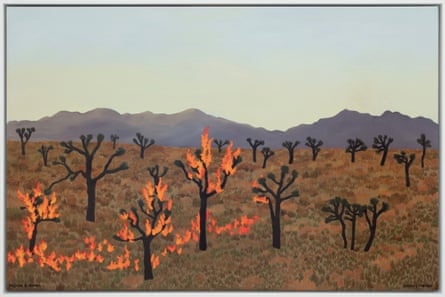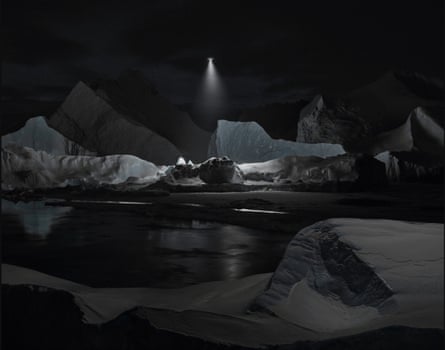“Climate change is a very complex topic that is not just about data and information and physics, it’s about culture and politics and psychological responses,” the author and newly minted museum curator Jeff Goodell said to the Guardian. “It’s about how we choose to live, what we value. The science part of it is a small sliver of the larger conversation – it’s really important, but it’s just the beginning of the conversation. There are vast dimensions of thinking about this subject that we have not really begun to approach.”
He’s speaking from Austin, Texas, where he’s putting the finishing touches on a new show at the Blanton Museum of Art at the University of Texas. Called If the Sky Were Orange, it seeks to bring complexity and curiosity to a climate change discourse that is often reduced to political polarization and degrees fahrenheit. Goodell hopes in talking about climate change in ways that are often not heard, the show will generate new thinking that might move us beyond the familiar impasses.
If the Sky Were Orange germinated over months of conversations, eventually becoming a sort of experiment in bringing together art and science and literature. The show collects an idiosyncratic and impressive grouping of nearly 60 works from as far back as the 17th century, combining them with specially commissioned writing from celebrated climate change writers. Among the writers here are the New Yorker journalist and Pulitzer prize winner Elizabeth Colbert, the celebrated Indian novelist Amitav Ghosh, the Canadian John Vaillant, whose recent book Fire Weather seems eerily predictive of the rampant wildfires currently burning across North America, and the Native American writer Julian Brave NoiseCat, a longtime journalist and advocate on how climate change affects Indigenous people.

“I was impressed at how eager and thrilled all the writers were to participate in this,” said Goodell. “They’re really an A-list of the best climate writers in the world. That made me think about how needed this collaboration was, because I really think there’s a lot of partitioning in this conversation about climate change. There’s this opportunity to try to reach more broadly and connect with people from very different disciplines.”
True to that aspiration toward broadness and connectivity, If the Sky Were Orange looks at climate change as an issue that goes all the way back to our species’ earliest relationships with energy. Sandra M Sawatzky’s Black Gold Tapestry – over 30ft in length – connects us to this enormous history by narrating humanity’s relationship with energy through nine centuries, from the 11th up through the 19th. “The tapestry is a wonderful piece,” said Goodell. “It uses an ancient and very traditional medium, very reminiscent of the Renaissance, to tell the story of the evolution of oil. It’s really lovely in that it’s a kind of storytelling about the long human history and connection around energy.”
Paired with this tapestry is Amitav Ghosh’s thoughtful reflection, arguing that the tapestry “creates a genealogy for humanity’s present predicament by placing it within history”. Ghosh goes on to say that this historicization of the climate struggle contradicts notions of the Anthropocene, which often try to say our own era is something completely broken off from the rest of human history. Reflections such as Ghosh’s are welcome amid the often unhelpfully overheated rhetoric surrounding catastrophic weather and global disruptions – as he notes, these tell us to think only of the future, thus making us forget our past.
Goodell is very much aware that Texas is a pointed place in which to stage a major exhibition around climate change: the state is of course one of the birthplaces of the fossil fuel industry in the US, and it remains the nation’s largest producer of crude oil. It has also borne much of the brunt of the climate crisis in the US. “From a climate change point of view,” said Goodell, “Texas is the belly of the beast. Houston was devastated by Hurricane Harvey and is very vulnerable to sea level rise. All of Texas this summer has shown breaking heat records. In my book I talk about crop failure. And drought is a huge issue in Texas.”

Goodell added that Texas itself was making a substantial transition to new kinds of energy, and this is also something he wants to portray in the multifaceted story he’s telling. “Texas is a leader in the nation in both wind and solar right now – we’re getting about 30% of power from renewable. The show tried to capture both the legacy and the responsibility that Texas has for the complex and compounding facts of climate change, as well as how it represents a kind of hope and energy for the future.”
In addition to talking about the long history of climate change, and concrete, contemporary issues around it, If the Sky Were Orange looks at the very epochal nature of the Earth transformations that are under way – indicating just how small we are by comparison. A video from Julian Charrière’s Towards No Earthly Pole, which shows a massive glacial landscape slowly melting in the depth of night as drone lights offer sporadic and partial illumination, gives audiences a confrontation with the impacts of climate change that is largely separated from cultural referents. For Goodell, this video hits an altogether different note than anything else in the show.
“Towards No Earthly Pole talks about time and history in a different way. Our understanding of the poles is very thin, so the history that is captured in this video, with these mysterious lights that shine on the ice, really suggests this deep time of this place that we know almost nothing about. And yet we are melting it, destabilizing it. That’s one of the basic tensions of the show.”
Ultimately, Goodell is excited and slightly relieved to be done with such a huge effort, and he is hopeful that If the Sky Were Orange will resonate. “One thing I learned from doing this,” he laughed, “is how hard putting together a museum show is. For sure I’ve never done anything like this before. Getting the tone right is really important. It’s not about scaring anyone, but it’s also not about soft-pedaling anything. Telling truths about this moment and exploring in new and different overlapping voices – that’s a difficult thing on such a polarized subject.”
-
If the Sky Were Orange: Art in the Time of Climate Change is on display at the Blanton Museum of Art in Austin, Texas, from 9 September until 11 February 2024